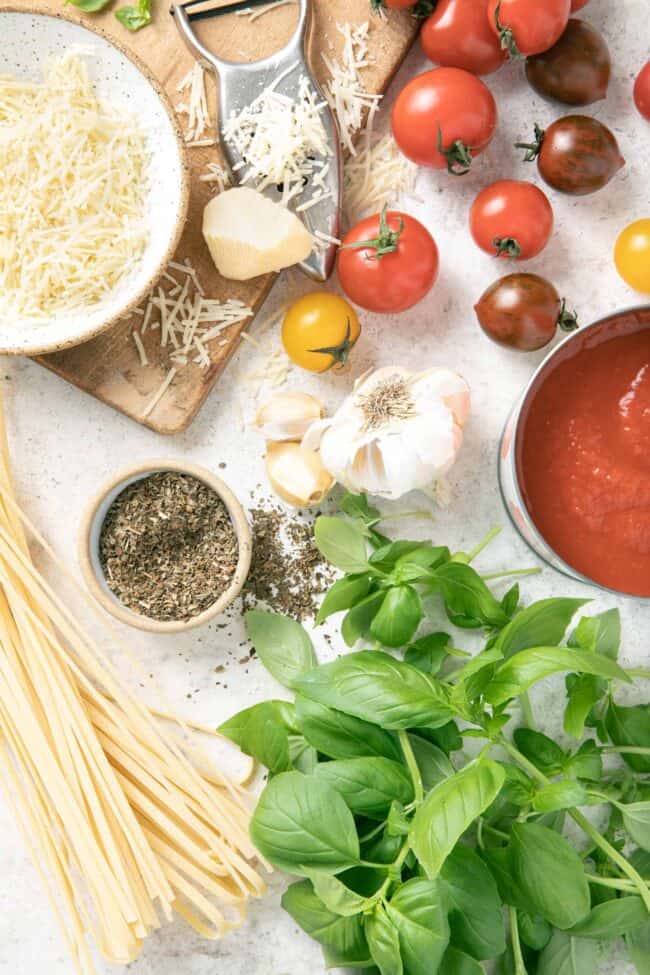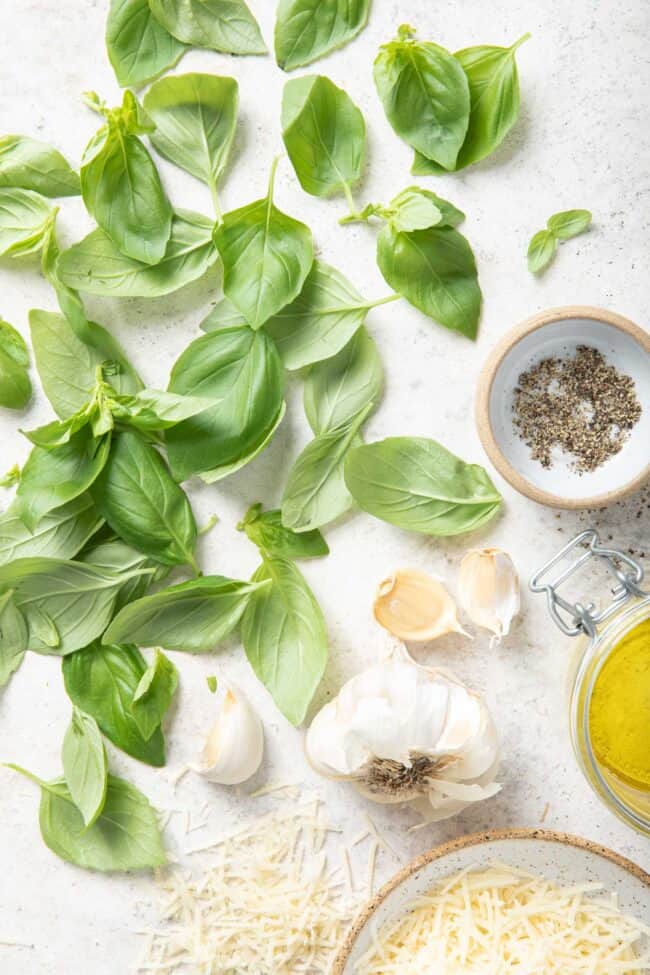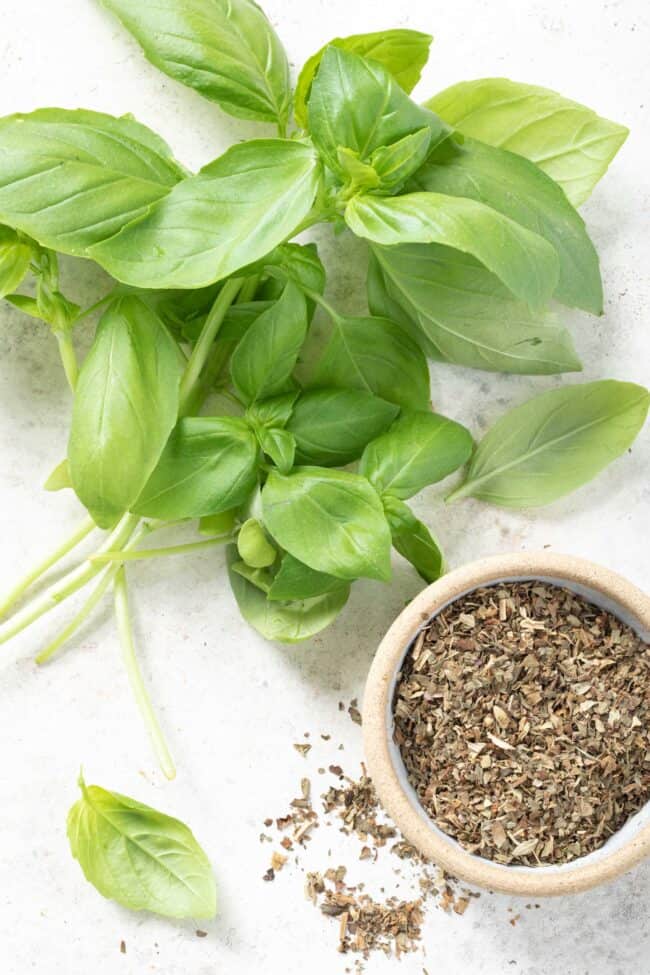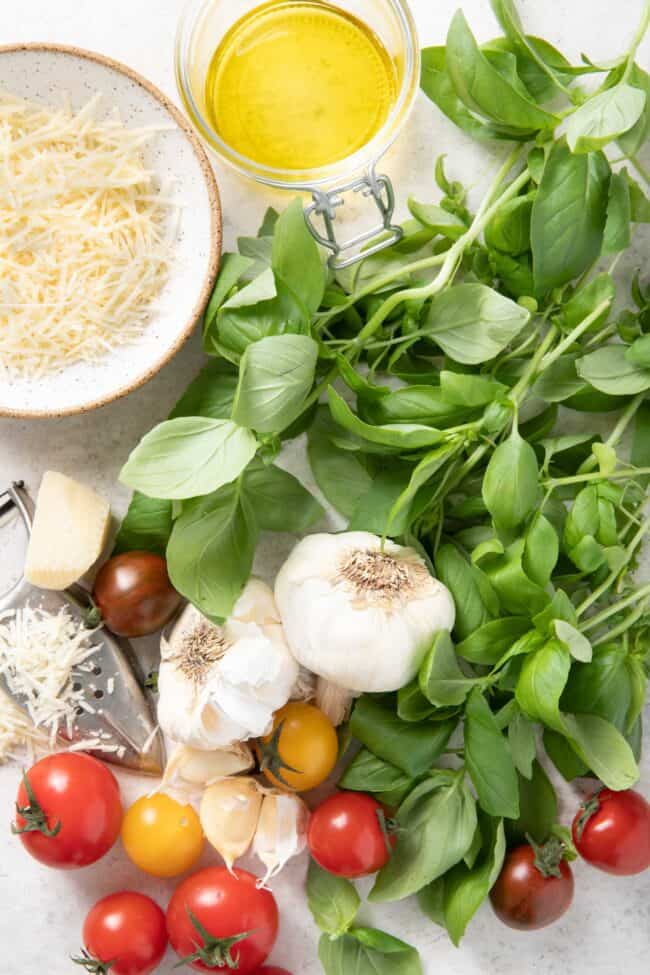Basil Substitute
Need a good substitute for basil? Fresh basil has a unique flavor that’s hard to replace. But if you’re in a pinch and need a basil substitution, here’s the best fresh basil substitutes you can use.
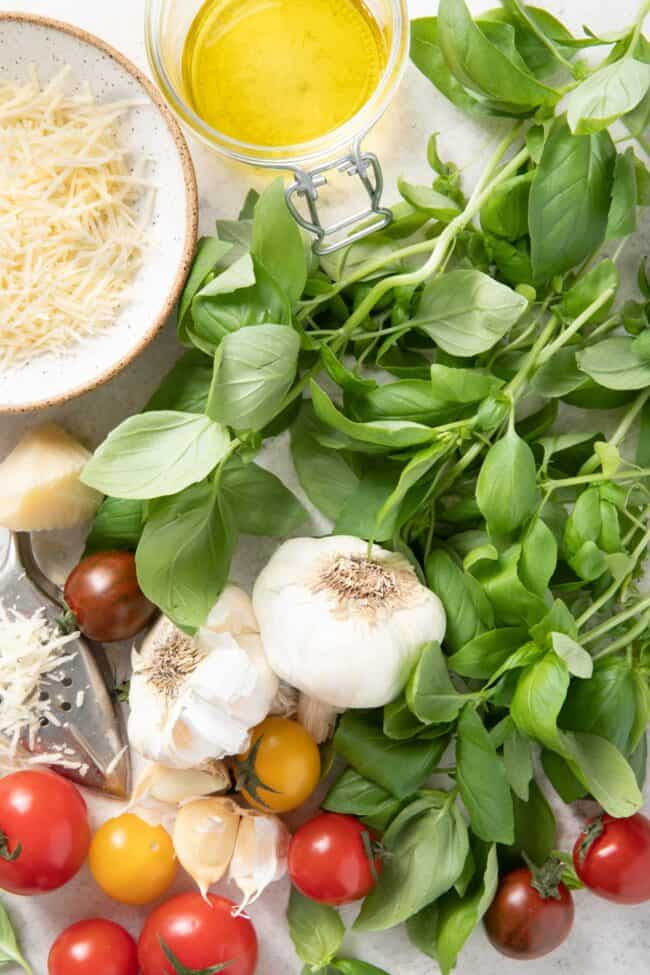
If you’re making a recipe that calls for basil and you don’t have any on hand, there’s a few substitutes you can use to replace it, though the flavor won’t be quite the same.
Fresh basil is a highly fragrant plant with leaves that are used for seasoning a variety of different foods, mostly Mediterranean and Italian dishes, and has a flavor that’s hard to match but you can substitute it with several different herbs (like parsley, celery leaves and fresh oregano).
What Is Basil?
Basil (Ocimum basilicum) is a leafy green culinary herb from the Lamiaceae family (mint family), which includes spearmint, peppermint and oregano. The name “basil” comes from the Latin word meaning “royal plant”. In France basil is also called “I’herbe royale” or “the royal herb”.
Types of Basil
There are several varieties of basil including, Sweet Basil (also called Genovese Basil), which is the most popular type of basil and is used in Italian and Mediterranean dishes; Holy Basil has a slightly minty flavor is often used for tea or use as a garnish; Sweet Thai Basil has an anise-licorice flavor and is often used in fish, salad and curry dishes; Lime Basil has a hint of citrus and is used in Asian cooking; and Cinnamon Basil has a cinnamon like taste and is used in legumes and spicy dishes.
Best Basil Substitutes
1. Parsley
Flat-leaf parsley leaves (also called Italian parsley) look a lot like cilantro and the two herbs comes from the same botanical family. Curly parsley has a mild flavor and is used mostly used as a garnish rather than to cook with. Parsley can be used as a basil substitution in pesto, garnish,
Use the same amount of fresh Italian parsley as you would use for fresh basil (a 1:1 ratio) and adjust to taste.
2. Celery Leaves
Celery leaves have a mild flavor that can be used as a substitute for basil in soups, stews, salads or as a garnish.
Use the same amount of fresh celery leaves as you would use for fresh basil (a 1:1 ratio) and adjust to taste.
3. Oregano
Oregano has an earthy and slight peppery flavor and is used in many of the same dishes as basil. Even though it isn’t as sweet tasting as basil, it can be used as a substitution for basil in savory dishes like meats and sauces.
4. Arugula
Arugula has an earthy peppery flavor that can be used as a substitution for fresh basil in salads, to top pizzas with, and in some savory dishes.
Use the same amount of arugula as you would use for fresh basil (a 1:1 ratio) and adjust to taste.
5. Baby Spinach Leaves
Baby spinach leaves are more delicate and mild tasting that mature leaves. They can replace basil leaves in soups, salads and pesto.
Use the same amount of baby spinach leaves as you would use for fresh basil (a 1:1 ratio) and adjust to taste.
6. Italian Seasoning
To substitute dried basil with Italian seasoning use 1/2 teaspoon Italian seasoning for every 1 teaspoon dried basil, and adjust to taste.
Fresh Basil vs Dried Basil
The ability to substitute fresh basil with dried will depend on the type of dish you are making. Dried basil can replace fresh basil in many recipes, like sauces, dressings, soups and stews. To substitute fresh basil with dried, use one-third the amount of dried as you would fresh. For example replace 1 tablespoon fresh basil with 1 teaspoon of dried.
Should You Rinse Basil Before Using It?
Fresh basil should be rinsed under cool running water before adding to a dish. Allow excess water to drip off the leaves over the sink then either gently pat them dry using a paper towel or put the sprigs in a salad spinner to dry.
How Do You Store Fresh Basil?
- Trim the stems and place the basil in a glass of water with a plastic bag covering the leaves. Store either on the countertop or the refrigerator if you have the space.
- Pick the basil leaves off the stems and lay them flat on a damp paper towel. Roll the paper towel up and put in a plastic bag and store in the refrigerator.
- Pluck the basil leaves off the stems and place in a freezer storage bag and lay flat in the freezer until the leaves are frozen. You can also quickly blanch the leaves and then bunch them up in ice cube tray compartments and freeze them into cube.
How Do You Cut Basil Ribbons?
- Gently pluck basil leaves away from the stem.
- Stack several leaves on top of one another and tightly roll them together.
- Holding the end of the tightly rolled leaves with one hand, using a sharp knife with your other hand, make thin slices across the rolled basil leaves into ribbons (also called “chiffonade”).
Cooking With Basil
For the best flavor and to retain the most nutrients found in fresh basil, add it at the end of cooking or sprinkle it on top of your dish after it has already been cooked. Add dried basil after half the cooking time for the most robust flavor in your dish. Before adding dried basil to your dish, rub it between your fingers to release the essential oils.
Fresh Basil Recipes
- Basil Pesto
- Basil Pesto Croutons
- Basil Pesto Chicken Salad
- Tomato Basil Scrambled Eggs
- Lemon Basil Vinaigrette
- Basil Mashed Potatoes
- Basil Berry Granita
- Basil Pesto Broccoli
- Sun Dried Tomato Vinaigrette
- Romaine Salad
- Italian Salad Dressing
More Resources
- Shallot Substitute
- Garlic Substitute
- Cinnamon Substitute
- Sour Cream Substitute
- Bay Leaf Substitute
- Rosemary Substitute
- Mint Substitute
- Cilantro Substitute
- Tomato Sauce Substitute
- Tomato Paste Substitute
- How Much Juice in One Lime
- How Much Juice in One Lemon
- How to Zest a Lemon
- How to Freeze Spinach
- How to Freeze Tomatoes
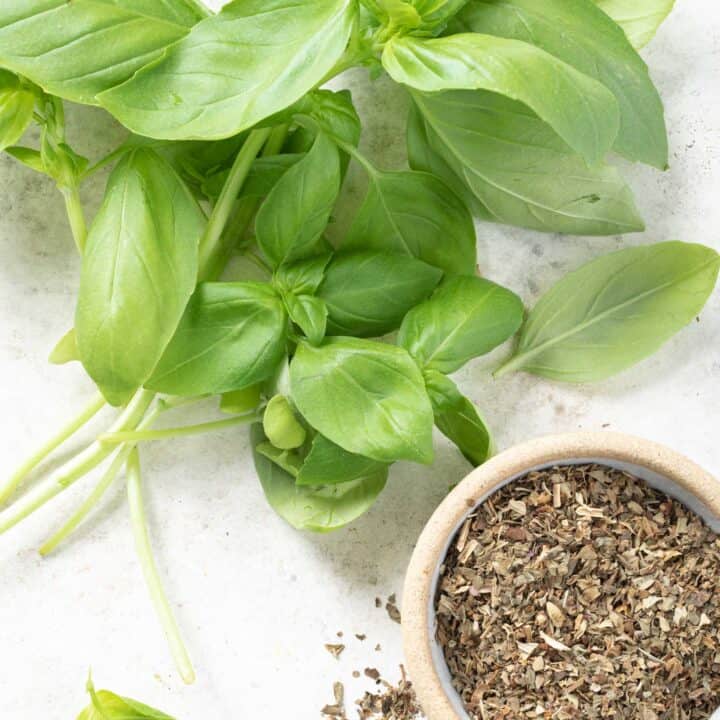
Basil Substitute
Need a good substitute for basil? Fresh basil has a unique flavor that's hard to replace. But if you're in a pinch and need a replacement, here's the best fresh basil substitutes you can use.
Ingredients
- 1 tablespoon Italian parsley
- 1 tablespoon celery leaves
- 1 tablespoon fresh oregano leaves
- 1 tablespoon arugula
- 1 tablespoon baby spinach leaves
- 1 teaspoon dried Italian seasoning
Instructions
- Flat-leaf parsley leaves (also called Italian parsley) look a lot like cilantro and the two herbs comes from the same botanical family. Curly parsley has a mild flavor and is used mostly used as a garnish rather than to cook with. Parsley can be used as a basil substitution in pesto, garnish, Use the same amount of fresh Italian parsley as you would use for fresh basil (a 1:1 ratio) and adjust to taste.
- Celery leaves have a mild flavor that can be used as a substitute for basil in soups, stews, salads or as a garnish. Use the same amount of fresh celery leaves as you would use for fresh basil (a 1:1 ratio) and adjust to taste.
- Oregano has an earthy and slightly pepper flavor and is used in many of the same dishes as basil. Even though it isn't as sweet tasting as basil, t can be used as a substitution for basil in savory dishes like meats and sauces. Use the same amount of fresh oregano as you would use for fresh basil (a 1:1 ratio) and adjust to taste.
- Arugula has an earthy peppery flavor that can be used as a substitution for fresh basil in salads, to top pizzas with, and in some savory dishes. Use the same amount of arugula as you would use for fresh basil (a 1:1 ratio) and adjust to taste.
- Baby spinach leaves are more delicate and mild tasting that mature leaves. They can replace basil leaves in soups, salads and pesto. Use the same amount of baby spinach leaves as you would use for fresh basil (a 1:1 ratio) and adjust to taste.
- Italian seasoning can be used to substitute dried basil. Use 1/2 teaspoon Italian seasoning for every 1 teaspoon dried basil, and adjust to taste.
Notes
How To Rinse Basil Before Using It
Fresh basil should be rinsed under cool running water before adding to a dish. Allow excess water to drip off the leaves over the sink then either gently pat them dry using a paper towel or put the sprigs in a salad spinner to dry.
How To Store Fresh Basil
- Trim the stems and place the basil in a glass of water with a plastic bag covering the leaves. Store either on the countertop or the refrigerator if you have the space.
- Pick the basil leaves off the stems and lay them flat on a damp paper towel. Roll the paper towel up and put in a plastic bag and store in the refrigerator.
- Pluck the basil leaves off the stems and place in a freezer storage bag and lay flat in the freezer until the leaves are frozen. You can also quickly blanch the leaves and then bunch them up in ice cube tray compartments and freeze them into cube.
How To Cut Basil Ribbons
- Gently pluck basil leaves away from the stem.
- Stack several leaves on top of one another and tightly roll them together.
- Holding the end of the tightly rolled leaves with one hand, using a sharp knife with your other hand, make thin slices across the rolled basil leaves into ribbons (also called "chiffonade").
Nutrition Information:
Yield:
1Serving Size:
1Amount Per Serving: Calories: 11Total Fat: 0gSaturated Fat: 0gTrans Fat: 0gUnsaturated Fat: 0gCholesterol: 0mgSodium: 17mgCarbohydrates: 2gFiber: 1gSugar: 0gProtein: 1g
theharvestkitchen.com attempts to provide accurate information, however, this nutritional information is provided as a courtesy and is an estimate only. The nutritional information provided comes from online sources and calculations. See full disclaimer on About page.
